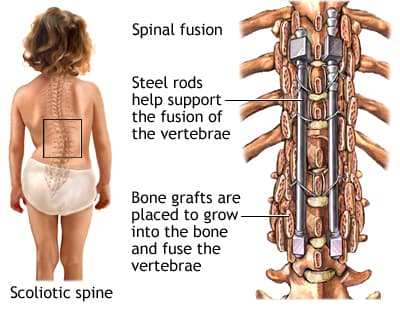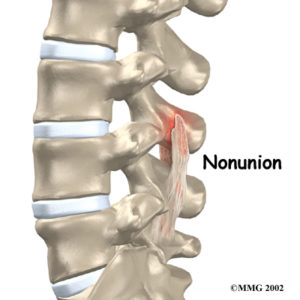How Common is Adolescent Scoliosis Revision Surgery?
A study published last month in Spine (a peer-reviewed medical journal) outlined the risks for re-operation and revision surgeries after Idiopathic Scoliosis Surgery.
The study looked at 1,435 patients from 12 different hospitals during the years 1995-2006. 80% of the patients included in the study were female with 76% having major thoracic curves. Most of the patients included had the medically standard rod and fusion surgery (see picture below) and were around age 15 when the surgery took place.

Number of Additional (revision of the initial operation) Surgeries Required Over 10 Years Post-Op
- 22 occurred within 3 mo postop / 1.7%
- 10 more before 1yr / 0.7% – (32 / 2.2% total revisions)
- 12 more before 2yrs / 0.8% – (44 / 3.1% total revisions)
- 20 more by 5yrs / 1.4% – (64 / 4.5% total revisions)
- 10 more after 5yrs / 0.7% – (74 / 5.2% total revisions)
Total at time of Publication : 75 or 5.2% of patients requiring re-operation
Why the need for additional surgery?? The Top Four Reasons Were:
-
Implant failure and/or failed spinal fusion also known as non-union.
-
Implant came out of place
-
Wound complication and/or infection
-
Leftover deformity and/or progression of the scoliosis.
“Revisions for scoliosis continues to occur well after two years…. Reasons for reoperation are not uniformly distributed over time; with implant related issues and infection the leading cause for early revision, while late infection was the most common cause after two years.”
The percentages reflected in this latest study are much lower than other recent studies have shown. Take a look at what previous scoliosis researchers have to say,
“Two papers were found on the topic of reoperation rates with a long-term follow-up of at least 10 years[17,18]. Reoperation rates were between 12.9%[18] and 47.5%[17].”
“Although the short-term complications may be minimal, long term complications have been estimated to exceed 50% with a rate of salvage surgeries of up to 25% [5,7,8].”
Hopefully the reduced complication rate of this latest study is because surgical techniques are improving!
However, the conclusions of these last authors remain the same as the earlier researchers: the rate of complications for spinal fusion surgery appears to increase with time.
Scientific research continues to show that there remains a lack of evidence to support a medical indication for AIS spinal fusion surgery (except in extreme cases). There is a lack of scientific evidence demonstrating that spinal fusion surgery improves the quality of life of AIS patients versus no treatment at all.

